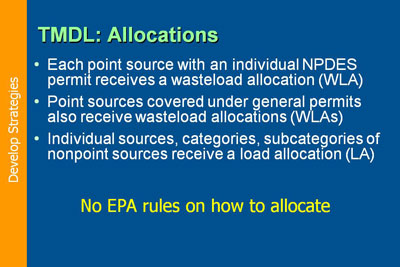TMDL Allocations
EPA regulations use the terms Wasteload Allocations (WLA) and Load Allocations (LA) to describe loadings assigned to point and nonpoint sources, respectively.
Generally, point sources that are required to have individual NPDES permits are required to be assigned individual WLAs. On the other hand, a group of sources covered under a “general” NPDES permit may be assigned one collective WLA.
Although ideally, load allocations should be assigned to individual nonpoint sources, this is often not practical or even scientifically feasible; hence, loads can be assigned to categories of nonpoint sources (all soybean fields in the watershed, for example) or to geographic groupings of nonpoint sources (all in a particular subwatershed).
Even though the CWA provides no federal authority for requiring nonpoint sources to reduce their loadings of pollutants to the nation’s waters, the act does require states (and authorized territories and tribes) to develop TMDLs for waters where nonpoint sources are significant sources of pollutants. TMDLs do not create any new federal regulatory authority over any type of sources. Rather, regarding nonpoint sources, TMDLs are a source of information that, for a given water body, should answer the following questions:
- Are nonpoint sources a significant contributor of pollutants to this water body?
- What are the approximate total current loads of a particular pollutant from all nonpoint sources in the watershed?
- What fraction of total loads of the pollutant of concern comes from nonpoint sources vs. point sources?
- What are the approximate loadings from the major categories of nonpoint sources in the watershed?
- How much do loads from nonpoint sources need to be reduced to achieve the water quality standards for the water body?
A common misconception about TMDLs is that EPA has issued regulations specifying how the pollutant cap in a TMDL should be allocated among sources—equal reductions for all or equal loadings from each, for example. EPA has no such regulations. States, territories, and tribes are free to allocate among sources in any way they see fit, so long as the sum of all the allocations is no greater than the overall loading cap. Nevertheless, when thinking about changing the share of allowed loads among sources, it is important to realize that in all but very small water body segments, load location matters. In many cases, the farther away from the zone of impact that a pollutant enters into the water body system, the less of an effect that load will have on the water quality limited zone. For example, studies of large watersheds, such as Long Island Sound, have indicated that one pound of pollutant (nitrogen, in the case of the Sound) discharged close to the impaired zone has the same impact on that zone as 10 pounds discharged substantially farther away. Furthermore, even after accounting for location-related relative impacts on a particular segment or zone, care must be taken to ensure that localized exceedances of WQS do not result from moving loads from one tributary/segment to another.
For more information on allocation of loads under TMDLs, check the Allocations: Definition and Options Web page.
![[logo] US EPA](https://www.epa.gov/epafiles/images/logo_epaseal.gif)
